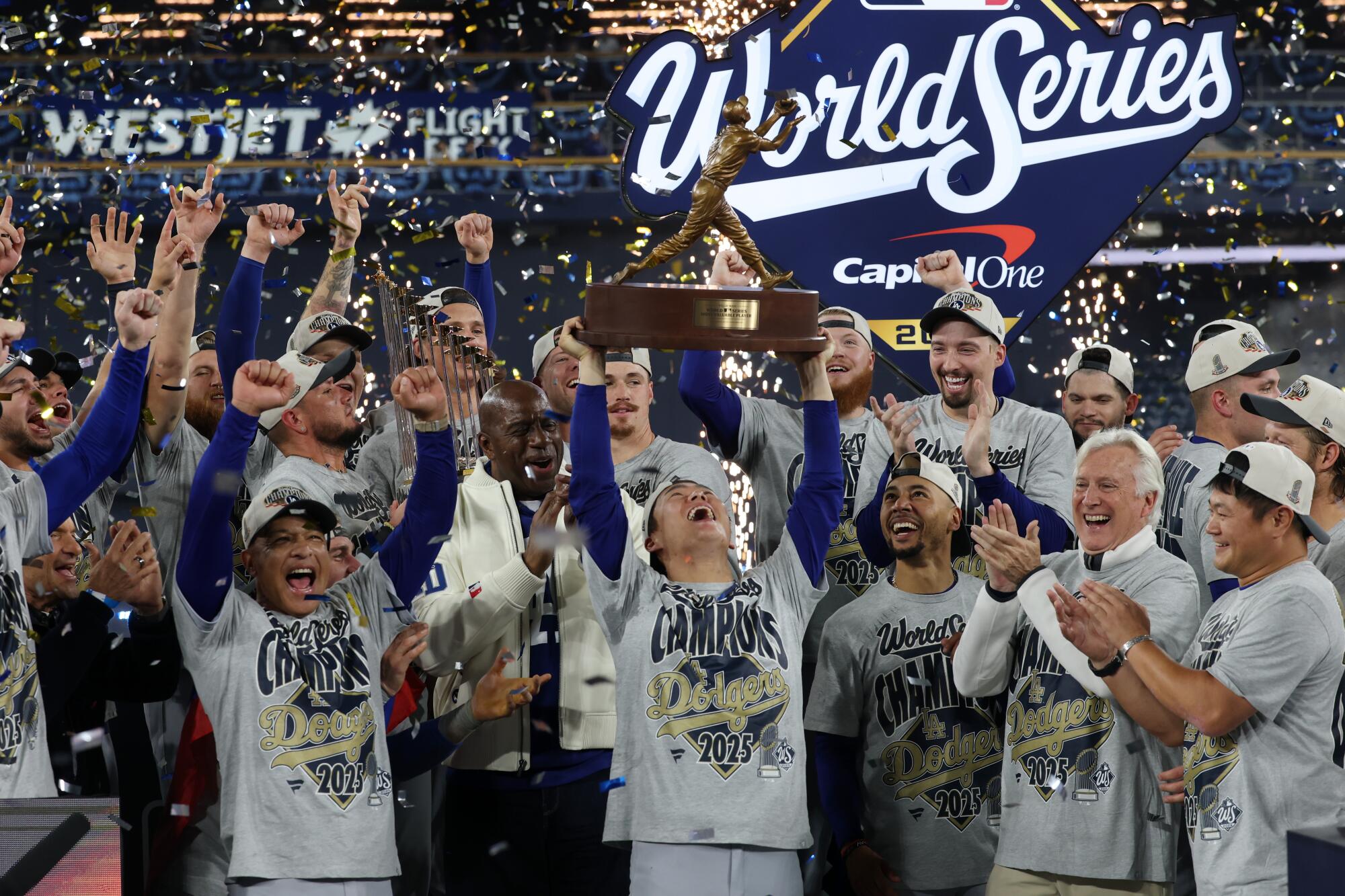Should Angels fans just give up and join the Dodgers bandwagon?
Christmas is three days away, and you’re running out of time to get a gift for the Angels fan in your life. How about a Dodgers cap?
If ever a winter posed a loyalty test, this one could. The Dodgers spent $69 million on Edwin Díaz, the best closer available in free agency, and another $2 million in championship parade costs. The Angels spent $2 million on a closer who put up an 8.23 earned-run average last season.
Next year the Dodgers will try to become the first National League team to win three consecutive World Series. The Angels will try to end baseball’s longest postseason drought at 11 years, still without much of a plan beyond rushing first-round draft picks to the major leagues while treading the financial waters until Anthony Rendon’s contract runs out.
On Sunday they missed out on Japanese slugger Munetaka Murakami, who signed with the 102-loss Chicago White Sox. Of the Angels’ five acquisitions this winter, three did not play in the majors last season, and not because they are up-and-coming prospects.
If you’re an Angels fan and you’re sick and tired of this, should you reconsider your loyalty?
Jim Bowden believes you should.
Bowden, formerly the general manager of the Cincinnati Reds and Washington Nationals, serves as a baseball insider on several media platforms. On “Foul Territory” last week he suggested fans of small-market teams have an option that might be more constructive than getting angry.
In Pittsburgh, for instance, the owner would rather complain about the lack of a salary cap than spend enough money to build a winner around generational pitcher Paul Skenes.
“You don’t have to be a Pirate fan,” Bowden said. “You can retire as a Pirate fan, or trade yourself to the Dodgers.
“If you want to see your team win, right now the Dodgers have got the best chance to win a World Series again. As a fan, you can root for any team you want.
“You don’t have to root for the team in your home city. You can see the Dodgers play in your home city. They’ll come into Pittsburgh and beat you.
“If it bothers you that much, just become a Dodger fan. It’s fine.”

Dodgers pitcher Yoshinobu Yamamoto celebrates with teammates, coaches and owners after the Dodgers’ World Series victory over the Toronto Blue Jays on Nov. 1.
(Robert Gauthier/Los Angeles Times)
The Angels no longer operate as a large-market team, and their circumstances could get even more dire in the near future.
On Sunday, Sports Business Journal reported that the parent company of FanDuel Sports Network is in jeopardy of shutting down if it cannot complete a sale to streaming service DAZN. The Angels would not disappear from your screens and streams, but it likely would mean the Angels would take a big cut in local broadcast revenue for a second consecutive year.
The Dodgers’ bandwagon shows no sign of slowing. The Dodgers set a franchise attendance record last season. They offer stadium tours in English, Spanish and Japanese. They launched a fan club in Japan.
So, as a frustrated Angels fan, you could hop on that bandwagon. Or you could try another large-market team — say, the New York Mets.
Mets owner Steve Cohen is worth $23 billion, according to Forbes. When Cohen bought the Mets in 2020, he said this: “If I don’t win a World Series in the next three to five years — I’d like to make it sooner — I would consider that slightly disappointing.”
The Mets still have not won a World Series since 1986. On Friday he took to social media to criticize “the usual idiots misinterpreting a Post article on Mets payroll.”
On Sunday, given the Mets’ losses of Díaz and beloved slugger Pete Alonso in free agency, New York Post columnist Mike Vaccaro shot back, comparing Cohen to greatly unloved former owner Fred Wilpon in this adaptation of a Christmas carol: “Steve’s beginning to look a lot like Wilpon/Mets fans say ‘Hell, no!’/What’s the point in being so rich/And a ruthless sonofabitch/If you don’t spend dough?”
The concept of fan free agency — essentially what Bowden suggested — is not new. Every now and then some disgruntled fan will publicly disown his favorite team, then invite rival teams to suggest why he should support them. If you’re creative enough, rival teams will send you some free swag.
That level of desperation is what many Dodgers fans felt a decade and a half ago, when former owner Frank McCourt needed a loan to cover payroll, hired a Russian physicist who channeled positive energy toward the team and “diagnosed the disconnects” among baseball operations personnel, and disparaged as “un-American” the league’s refusal to approve a television contract that he said would have provided the revenue to keep the Dodgers out of bankruptcy court.

Fans wearing Shohei Ohtani Dodgers jerseys wait to enter Angel Stadium before a game between the Angels and Dodgers on Aug. 12.
(Luke Hales / Getty Images)
In 2011, the year McCourt took the team into bankruptcy, the Angels outdrew the Dodgers for the only time. The Dodgers fans did not bail on their team. They waited for better days.
That is where Angels fans are now — and, for that matter, where Pirates fans are too. Bowden’s suggestion that unhappy Pirates fans exhausted by the perennial futility try the Dodgers did not go over well in Pittsburgh. At the Pirates’ fan site Rum Bunter, Emma Lingan wrote: “Fandom isn’t a streaming subscription you cancel when the content gets bad.”
This year’s World Series was the best and most dramatic I ever covered. But the one that was the most fun was the 2002 World Series: the underdog Angels, the Disney team no one projected for a happy ending, rampaging through October and toppling giants. As The Times’ headline on the Game 7 victory put it: “Fantasyland!”
If you were there in 1982 and 1986, when the Angels had six chances to win one game to clinch their first World Series appearance — and lost all six — then you could have a greater appreciation of 2002. And, if you were there for McCourt bankruptcy, you can have a greater appreciation of Guggenheim majesty.
So get that Angels fan in your life an Angels cap. That fan will be able to wear that cap proudly one of these years, and all the tears will make the cap fit that much more snugly.












